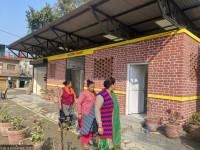Money
Gandaki first province to regulate ride-hailing, Bagmati to follow
A Bagmati provincial parliamentary committee proposes that the government monitor software developed by private companies, including real-time access to ride data.
Krishana Prasain & Anup Poudel
Gandaki Province enforced guidelines to regulate ride-hailing companies on Tuesday while Bagmati is reviewing a draft regulation to bring the services under provincial oversight and taxation.
A draft of new ride-sharing guidelines currently under discussion in the Bagmati provincial parliamentary committee proposes monitoring of software developed by private companies, including real-time access to ride data.
The proposed rules would allow provincial authorities to access the ride-sharing platforms’ backend systems, granting them visibility into pick-up and drop-off locations, fare amounts, and other ride details.
This is to bring ride-sharing companies under taxation, said an official at the Bagmati provincial Ministry of Labour, Employment and Transport.
Birendradev Bharati, secretary at the same ministry, said the province is working to introduce its regulatory framework, which was modelled on a guideline recently enacted in Gandaki Province.
“Gandaki Province has implemented the ride-sharing guidelines, and we will soon introduce a version that incorporates their provisions,” Bharati said. He added that the guidelines are expected to pass from the ongoing budget session of the provincial assembly.
The regulation aims to formalise and oversee ride-hailing companies operating through mobile apps. The draft requires companies to register with the provincial government, establish a local office, ensure passenger safety, and adhere to regulated fare structures.
In February 2023, the federal government amended the Industrial Enterprises Act (2020), officially recognising ride-hailing as a legal, service-oriented business in Nepal, seven years after such services started. However, regulatory gaps remain.
The Pushpa Kamal Dahal-led government had tabled an earlier version of the ride-sharing guidelines, but work had to restart after a change in the ruling coalition.
In January 2024, the Supreme Court directed the government to expedite legislation regulating ride-hailing platforms, citing the sector’s rapid growth and lack of oversight.
Following the Supreme Court’s directive, Gandaki Province officially became the first to legalise ride-sharing.
On Tuesday, the provincial cabinet approved its guidelines, which require ride-sharing and vehicle rental service operators to register with the provincial transport office within 30 days of the guidelines’ implementation.
However, the decision has not gone unchallenged.
The Federation of Nepalese National Transport Entrepreneurs and several transport labour unions on Thursday strongly opposed the new rules.
They claim the guidelines contradict the Motor Vehicles and Transport Management Act of 1993, and are calling for their immediate revocation. Some entrepreneurs have threatened to suspend vehicle operations if the guideline is not withdrawn.
Under Gandaki’s new rules, unregistered ride-sharing and vehicle rental service operators face a fine of Rs100,000.
Companies offering two-wheeler ride-sharing or rental services must pay an approval fee of Rs25,000 and an annual renewal charge of Rs12,500. For four-wheelers, the fees rise to Rs50,000 and Rs25,000, respectively.
Interestingly, while the guideline sets out these registration and approval fees, it does not yet specify fare rates for ride-sharing or rental services.
To register with a ride-sharing company, a two-wheeler owner must pay Rs500, while a four-wheeler owner pays Rs2,000. The companies must submit Rs5,000 for each two-wheeler and Rs20,000 for each four-wheeler as a service charge to the transportation office.
Although vehicle owners are exempt from annual renewal charges, ride-sharing companies can collect a service fee of up to 12 percent per transaction from affiliated riders or drivers.
The Gandaki guidelines also impose operational limits. Registered vehicles may not operate beyond a 20-kilometre radius, and riders are not allowed to work more than 12 hours a day.
The guidelines prohibit giving rides to passengers accompanied by children under 10 or the elderly.
Additionally, riders must have held a driver’s licence for at least a year to be eligible for registration. All registered vehicles must carry third-party insurance, as well as coverage for the rider and passengers, in compliance with existing laws.
Nepal's ride-sharing saga began making legal headlines in 2019 when advocate Shyam Kumar Shrestha filed a petition for the cancellation of Pathao Nepal’s registration.
The Supreme Court refused to issue a stay order and later dismissed the petition altogether on June 27, 2019.
The full text of the verdict was only released last month, passed by then-chief justice Bishwambhar Prasad Shrestha and Justice Tek Prasad Dhungana.
In 2020, the Patan High Court also instructed the government to regulate ride-hailing services. Despite this, legislation to govern the sector remains incomplete.
Although ride-hailing is currently governed under the Industrial Enterprises Act, a comprehensive regulatory framework is still lacking.
The controversy surrounding ride-sharing escalated following the auditor general’s 61st annual report, which flagged concerns over using private vehicles for commercial purposes, lack of registration with the Department of Transport Management, and potential tax evasion.
The report criticised the absence of proper regulation and tax compliance in the rapidly expanding sector.
The Motor Vehicles and Transport Management Act (1993) prohibits the use of private vehicles for commercial transport, complicating tax collection and enforcement efforts for ride-hailing companies that operate in a regulatory vacuum.
This legal ambiguity has raised concerns about fair competition, passenger safety, and labour rights for gig economy workers.
Until clear national legislation is enacted, provincial governments like Gandaki and Bagmati are stepping in to fill the void, though not without resistance from traditional transport operators.




 18.12°C Kathmandu
18.12°C Kathmandu















